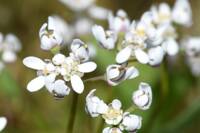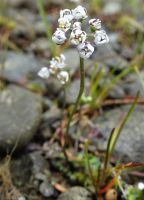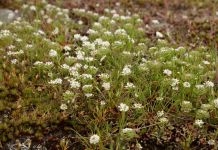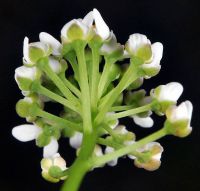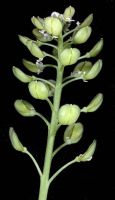Distribution: Occurring chiefly west of the Cascades crest in Washington; British Columbia to California, also in northeastern U.S.
Habitat: Sandy or gravelly soil at low elevations.
Flowers: March-May
Origin: Introduced from Europe
Growth Duration: Annual
Conservation Status: Not of concern
Pollination: Bees, flies, butterflies
Glabrous, annual herbs, the stems single, simple or freely-branched from the base, 5-25 cm. tall.
Leaves mostly in a basal rosette, 1.5-5 cm. long, slender-petiolate, the blades oval to oblanceolate or obovate, entire to lyrate-pinnatifid.
Inflorescence a terminal, bractless raceme, the stem scapose or with 1-several bract-like, entire to deeply-lobed leaves; pedicles slender, divergent, 4-8 mm. long; sepals 4, not saccate, often purple-tinged, about 0.5 mm. long; petals 4, white, 1 mm. long; stamens 6, the filaments with broad, scale-like, whitish, basal appendages; style lacking.
Silicles strongly obcompressed, oblong-obovate, 3-3.5 mm. long and nearly as wide, the valves keeled and slightly winged above; seeds 2 in each cell.
Publication: Hortus Kew. 4: 83. 1812.
PNW Herbaria: Specimen records of Teesdalia nudicaulis in the Consortium of Pacific Northwest Herbaria database
WA Flora Checklist: Teesdalia nudicaulis checklist entry
OregonFlora: Teesdalia nudicaulis information
E-Flora BC: Teesdalia nudicaulis atlas page
CalPhotos: Teesdalia nudicaulis photos




